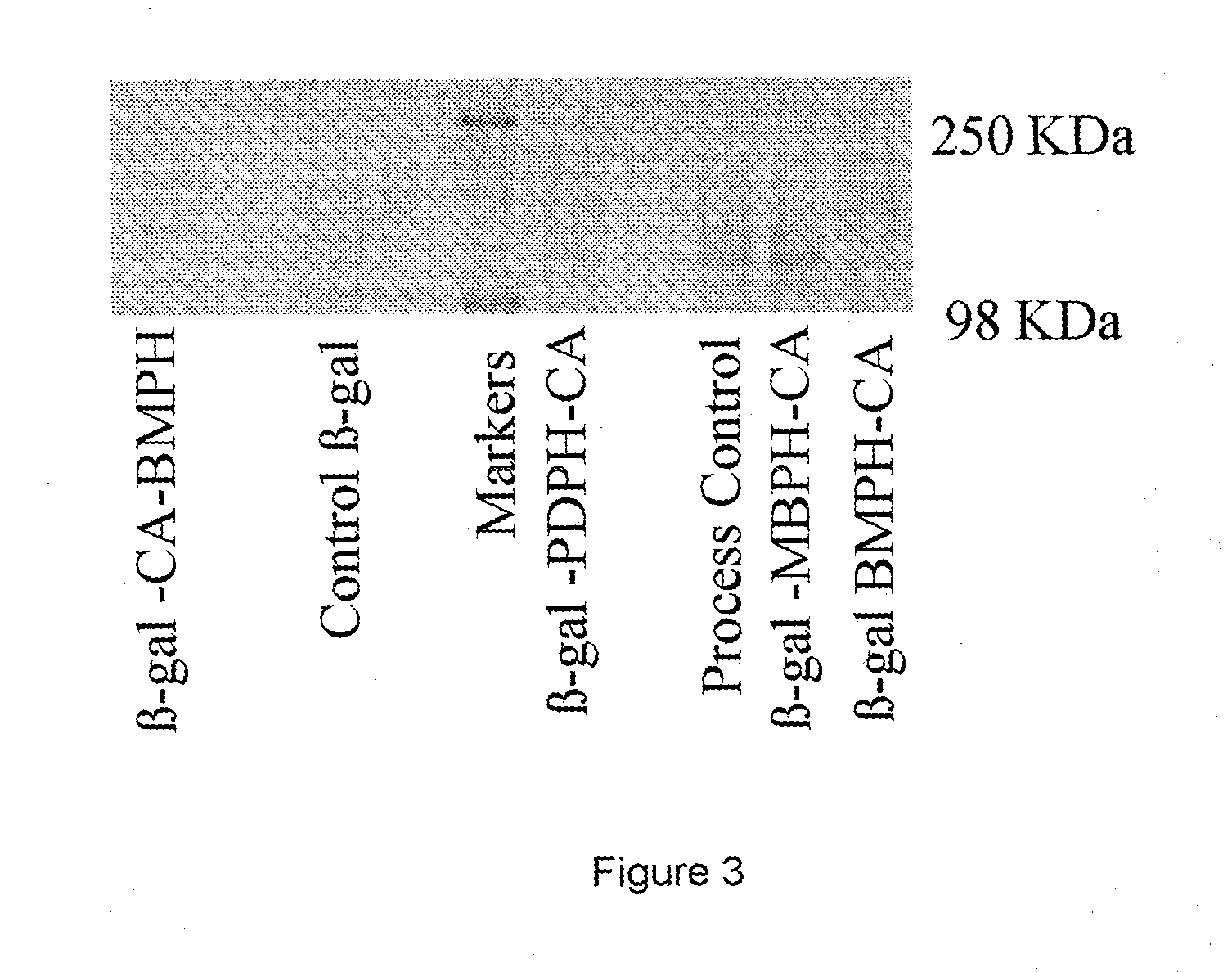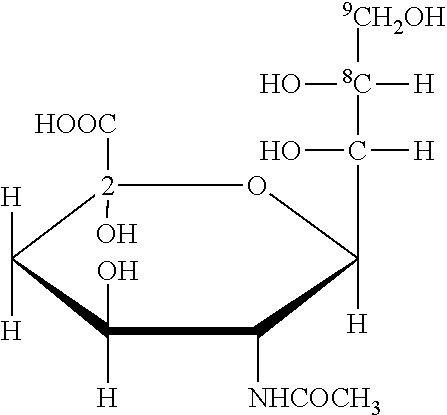Polysialic acid derivatives
a technology of polysialic acid and derivatives, applied in the field of polysialic acid derivatives, can solve the problems of undesirable accumulation of pegylated proteins intracellularly, non-biodegradable peg,
- Summary
- Abstract
- Description
- Claims
- Application Information
AI Technical Summary
Benefits of technology
Problems solved by technology
Method used
Image
Examples
example 1
[0039]
[0040]1.1 Synthesis
[0041]Three separate preparations were carried out as follows:
[0042]Colominic acid aldehyde (CAO) produced according to WO-A-9222331 (100 mg, 4.4×10−6 mol) was dissolved into 500 μl 0.1 M sodium acetate, to this 5 molar equivalents of N-[β-maleimidopropionic acid]hydrazide (6.5 mg, 2.2×10−5 mol) was added. This mixture was then vortex mixed and wrapped in foil and allowed to incubate at 37° C. for 2 h on a rotary mixer. The polymer was then precipitated by the addition of 2 volumes (1.0 ml) of ethanol. The precipitate was collected by centrifugation (13,000 rpm, 2 min) in a bench top microcentrifuge. The supernatant was discarded and the pellet dissolved in 500 μml 0.1 M acetate. This process was repeated a further 2 times and the final pellet dissolved in deionised water and freeze dried overnight.
[0043]1.2 Assay for Maleimide Content
[0044]In this assay cysteine is reacted with the maleimide on the polymer preventing further reaction with Ellman's Reagent (...
example 2
Synthesis Route 2
[0065]Step 1 Amination of CA-Aldehyde (CHO)
[0066]Step 2 Introduction of Maleimide Ring
[0067]Synthesis
[0068]2.1 Step 1 Amination of Oxidised CA
[0069]Oxidised colominic acid at (CAO) 10-100 mg / ml was dissolved in 2 ml of deionised water with a 300-fold molar excess of NH4Cl, in a 50 ml tube and then NaCNBH3 (5 M stock in 1 N NaOH(aq) was added at a final concentration of 5 mg / ml. The mixture was incubated at room temperature for 5 days. A control reaction was also set up with colominic acid (A) instead of CAO. Product colominic acid amine derivative was precipitated by the addition of 5 ml ice-cold ethanol. The precipitate was recovered by centrifugation at 4,000 rpm, 30 minutes, room temperature in a benchtop centrifuge. The pellet was retained and resuspended in 2 ml of deionised water, then precipitated again with 5 ml of ice-cold ethanol in a 10 ml ultracentrifuge tube. The precipitate was collected by centrifugation at 30,000 rpm for 30 minutes at room temperatur...
example 3
Preparation of Iodoacetate Derivative of Colominic Acid (CAI)
[0076]
[0077]3.1 Synthesis
[0078]To 40 mg colominic acid amine (85 mol % amine) as (described in Example 2.1) dissolved in 1 ml of PBS pH 7.4 was added 5 mg of N-succinimidyl iodoacetate (SIA). The mixture was left to react for 1 h at 37° C., after which excess SIA was removed by gel filtration over a 5 ml Hightrap™ Desalting column(AP Bioscience) eluted with PBS. 0.5 ml fractions were collected from the column and samples from each fraction tested for colominic acid content (resorcinol assay) and reactivity with cysteine indicating iodide (Ellman's Assay). Fractions positive for both iodide and CA were pooled.
[0079]3.2 Conjugation of CAI to β-galactosidase
[0080]To E. coli β-galactosidase (5.0 mg, 4.3×10−8 mol) in 1 ml PBS 15 mg CAI was added (6.59×10−7 mol, 15 molar equiv). The tube was sealed wrapped in foil and allowed to incubate at room temperature for 1 hr. whilst gently mixing. The resulting conjugate was analysed by ...
PUM
| Property | Measurement | Unit |
|---|---|---|
| volume | aaaaa | aaaaa |
| concentration | aaaaa | aaaaa |
| concentration | aaaaa | aaaaa |
Abstract
Description
Claims
Application Information
 Login to View More
Login to View More - R&D
- Intellectual Property
- Life Sciences
- Materials
- Tech Scout
- Unparalleled Data Quality
- Higher Quality Content
- 60% Fewer Hallucinations
Browse by: Latest US Patents, China's latest patents, Technical Efficacy Thesaurus, Application Domain, Technology Topic, Popular Technical Reports.
© 2025 PatSnap. All rights reserved.Legal|Privacy policy|Modern Slavery Act Transparency Statement|Sitemap|About US| Contact US: help@patsnap.com



